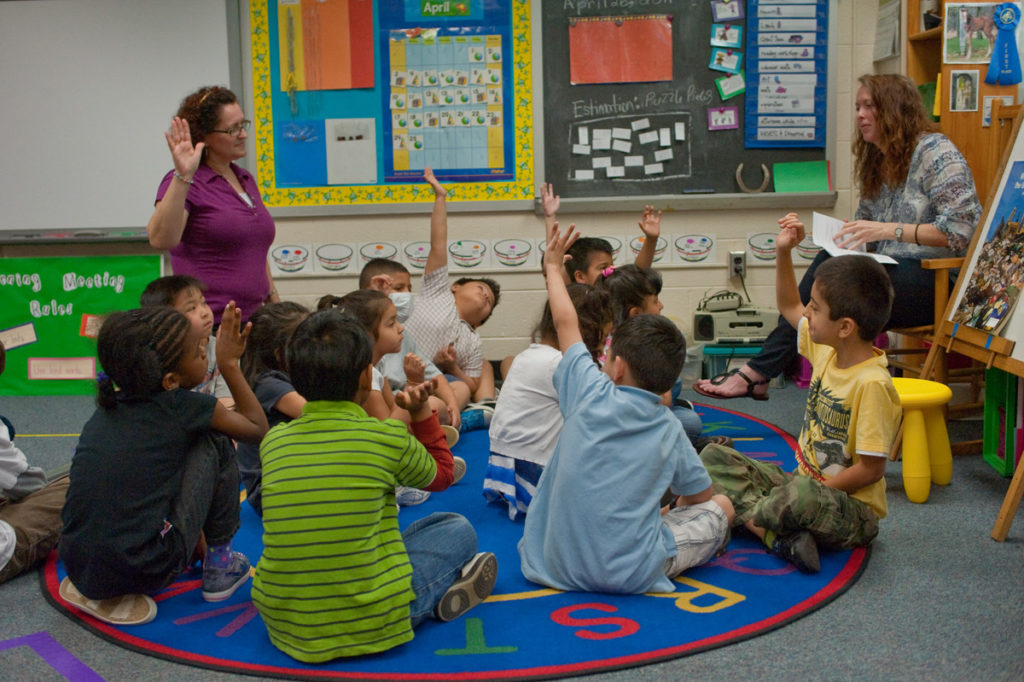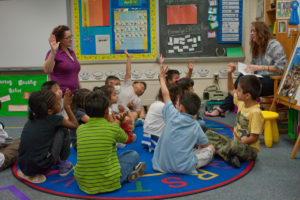

At School 14, every adult in the building (including cafeteria, custodial, and clerical staff) attends Morning Meetings. One of the visiting adults takes over the Morning Meeting for teachers who are visiting other classrooms. This well-coordinated Morning Meeting visiting program began in September 2001. Its goals: Enable staff to more easily learn from each other and help children get to know all the adults in the building.
One teacher said that before the visits began, “teachers came in, went to their classrooms, closed their doors, and just did their own thing.” Now, they form a much more cohesive group of colleagues who share knowledge not only about the components of Morning Meeting but also about other instructional practices. “One month I might go visit another teacher in my grade level to see how she’s doing her charts,” says third grade teacher Nicole Almazi. “Another time I might see what a fourth grade teacher is doing so that I know how to prepare my students for what’s ahead next year.”
The teachers also get to know each other better. “After visiting another teacher’s room, you have a better understanding of what your colleague’s skills and talents are,” says former principal Rosetta Wilson, under whose guidance the visiting program began. As a result, when teachers need help in a specific area, they know which of their colleagues to ask. Plus, their cohesiveness as a staff enables them to take professional risks and encourages them to work collaboratively. The visits “reinforce our common mission and allow us to really work as a team to help kids learn,” says Rosetta.
For students, welcoming visitors to Morning Meeting offers an opportunity to become familiar with and more trusting of all the adults who are part of their school community. Casilda Jewell, a first grade Reading Recovery teacher, notes that “having adults visit Morning Meetings helps kids get to know all of us.”
Another important benefit for the students is that they regularly see their teachers and other adults modeling cooperative behavior. As reduced-class-size instructor Ginny Bonora says, “Adults can be in classrooms together, watch each other, give input, and it’s O.K.”
Several structures enable teachers at School 14 to visit other classrooms without disrupting the instructional day.
Having a designated time for Morning Meeting helps ensure that teachers can visit each other’s classrooms. The school office regularly gathers teachers’ requests to visit classrooms and sends out visit schedules. Teachers visit one other classroom for one Morning Meeting each month.
At the beginning of each year, the office also constructs a schedule for the Morning Meeting visits of support staff, special area teachers, and non-instructional personnel. For a month, these adults join one classroom’s Morning Meeting. The following month, they switch to another classroom. On mornings when the classroom’s teacher is visiting elsewhere, the visiting adult leads the children in Morning Meeting.
School 14 provides every adult in the building with at least basic training in the Responsive Classroom approach and Morning Meeting in particular. “Everyone on staff has the same baseline knowledge,” says fourth grade teacher Rosemary Gerry.
At School 14, there is a strong sense of community and a common purpose among the staff: to help everyone, children and adults, learn. Rosetta modeled this kind of collaboration. “She was open to new ideas and gave us structures and techniques for working together,” says first grade teacher Giovanna Rodriguez. “Now we’re more able to get and give feedback in a caring environment.”
School 14 Demographics
Setting: Urban
Grades: 1–4
Number of students: 199
% of students eligible for free or reduced-price lunch: 73%
Number of full-time staff: 47, including non-instructional staff